Show:
Why and When To Check Your E-mail Deliverability
In order to run a successful business, you need to be able to entice consumers to do business with you. So whether you are trying to enter a new market or trying to expand your existing customer list – the question is, How do you do that?
What is the best way for you to reach out to your potential customers and convince them to visit your store to make a purchase?
Out of all the popular methods, email marketing continues to be the most powerful tool for this purpose. In fact, this strategy can get you an average ROI of $42 for every dollar spent.

However, such impressive rates are only applicable if you get email marketing right.
Using Emails for Marketing Campaigns
Emails are one of the popular ways that businesses use to establish trust and relationships with their customers.
It is a tried-and-tested method that will help you generate leads, and retain your existing ones. Despite the strong emergence of social media platforms, email marketing is still deemed efficient to nurture leads at a reasonable cost.
For example, you can use some free online tools to find email addresses, or you might be acquiring leads from your website visitors, blogs, organic traffic, ads, etc. Regardless of where you source your leads, you can use customized emails to provide exactly what these leads are looking for.
However, without proper analytics, you will never know whether your email campaigns are getting you any returns. This is where email deliverability comes in.
The Importance of Email Deliverability
Email deliverability is when an email you sent has been successfully delivered to a person’s inbox.
For those unaware – notice that email deliverability is different from email delivery. The latter will only tell you if your emails have been delivered to the receiving server.
As such, you need to know the deliverability – which is crucial to ensure that your emails are not landing on your prospect’s spam folder but in their primary inbox.
Although it might be impossible to know exactly what percentage of your emails reach the inbox, it is possible to make inferences based on some other key metrics such as bounce rates, open rates, click-through rates, and spam complaints.
This can give you additional insight into how your leads engage with your emails.
When to Test Email Deliverability
There are two main scenarios where you should test your email deliverability:
Before starting an email campaign
During your email campaign
This will give you a clear idea of how your campaign is performing when compared to the statistics before rolling out a new marketing strategy.
What Factors Affect Your Email Deliverability?
Most commonly, your email deliverability is determined by the authenticity of your messages.
Whenever an email arrives in a mail provider, it checks on the incoming message. In addition, if you want to avoid ending up in the spam folder, you can also take care of the following aspects:
- Send emails only to your Subscribers
The main reason that your emails are landing on spam is that you are sending them to those who unknowingly joined your list. This means that if they do not know your product, they are likely to delete it or send it to spam. This way, all your future emails will also be forwarded to the spam folders.
- Send Welcome Emails Immediately
If you wait too long to welcome a new subscriber, they might not remember signing up on your platform and might mark your emails as spam. To avoid this, make sure you send a welcome email as soon as possible or within the first 24 hours. Not to worry, there are plenty of automated email marketing tools that can help you with this.
- Send form your Company Domain Name
Sending emails from free accounts such as Gmail or Hotmail is another indicator of spam for inbox providers. Make sure you set up a company email address and have a reputable ‘from name’ as well. For instance, you can include ‘Justin from ABCCompany,’ which will add more authenticity in the eyes of the spam filters.

As you see in this example, the Sender name is given as ‘Ben from Seedlip’ – which will tell mail providers that it is indeed an actual person from a verified company domain that is sending the email. Moreover, it will also come across as more personal to your customers.
- Avoid Spam Words
Spam filters are actively looking against buzz words such as ‘earn extra money’ or ‘100% legitimate’. However, depending on the spam filters, this could even be expanded to terms such as ‘order now.’
If at all you are using words that might come across as spam, make sure to provide some context.
How to Check Email Deliverability
Fortunately, there are a number of programs that allow you to check your email deliverability rate. On a global level, the average inbox placement rate was 83%. However, this will vary widely depending on your industry, your promotions, and the time you sent the emails.
In this part of our article, we will introduce you to some of the popular tools that you can use to measure email deliverability.
1. MailTester.com – To Check Deliverability Score
MailTester is one of the top-notch tools available that can tell you how your emails come across to your customers. In short, it looks at the different metrics that might be lowering your email deliverability.
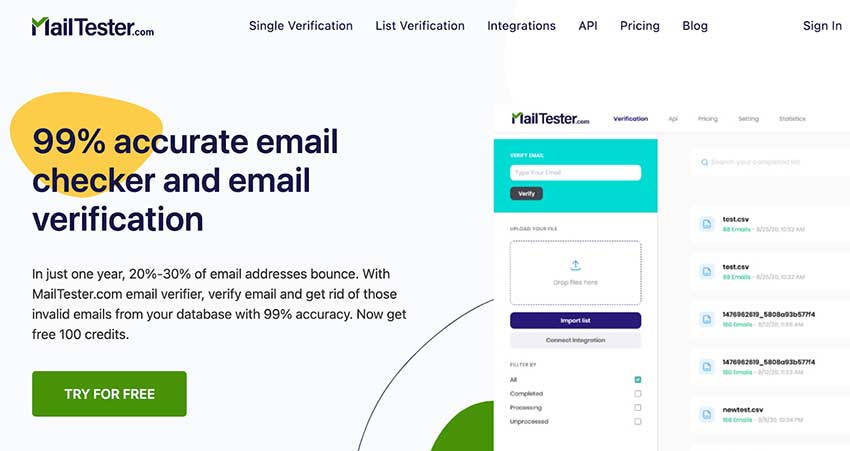
For instance, the program will:
- Identify and remove duplicate contacts
- Searches for spam trap emails
- Removes hard bounces
- Eliminates emails that match your complainer databases
- Get rid of emails with inactive domains
You can also upload bulk email lists or individual ones to receive reports.
Based on these different factors, the tool will give you a general score between 0 to 10. Ideally, you need a score close to 10 to ensure high email deliverability.
If your score comes out five or below, you should make the relevant changes before you send it.
2. Spamcheck – To Boost your Email Content
Spamcheck is a special tool of the Postmark app, which is a full-fledged email marketing tool that caters to different aspects of running a successful campaign. This specific tool is quite simple and free to use.
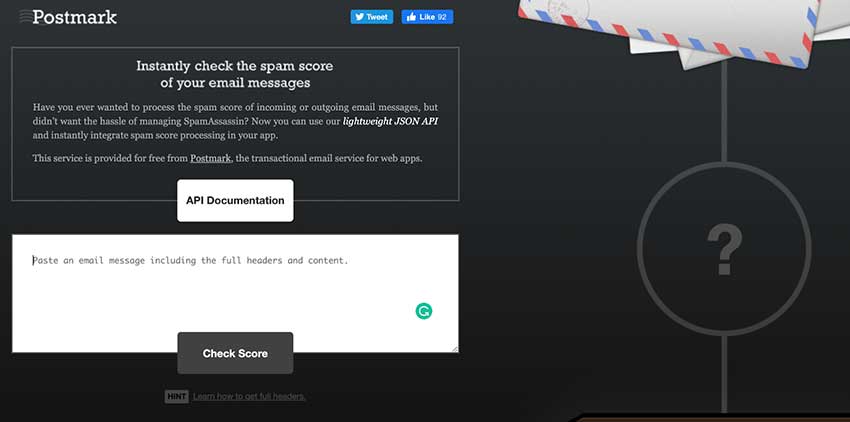
All you need is to enter your email body, and the Spamcheck will give you a spam score. A low score will mean that your content will pass through the filters, whereas a high score indicates that your email will be flagged as spam.
The best thing about this tool is you do not have to download or sign up. This is completely web-based and will even point out which aspects of the content you need to improve.
3. Mailchimp – Best for Overall Email Marketing Automation
Similar to PostMark, Mailchimp is another all-in-one tool for marketing. It provides AI-powered and user-friendly features for you to design your email templates, automate your campaigns, and most importantly, perform real-time analytics.
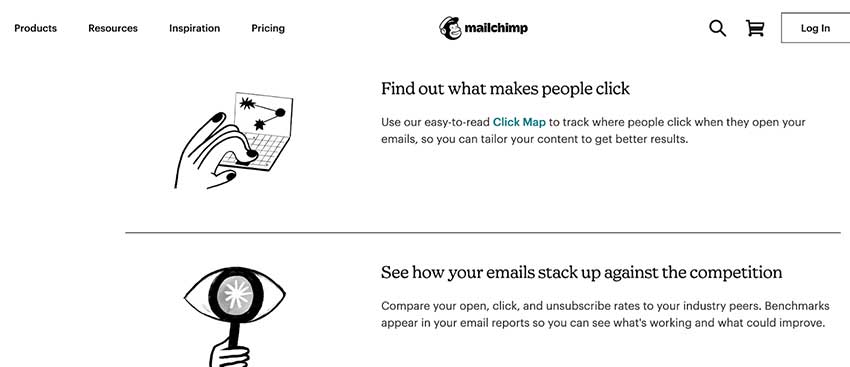
You will be able to compare your open, click, and unsubscribe rates to your competitors. Mailchimp will also display the benchmarks in your reports to know what aspects of your email you need to improve.
4. GlockApps – Get your Inbox Insight Score
GlockApps can pinpoint all the issues in your emails that lower your click-through rates and increase your bounce rates. Although the tool comes packed with plenty of useful features, we will focus on its Inbox Email Tester and Inbox Insight Score.
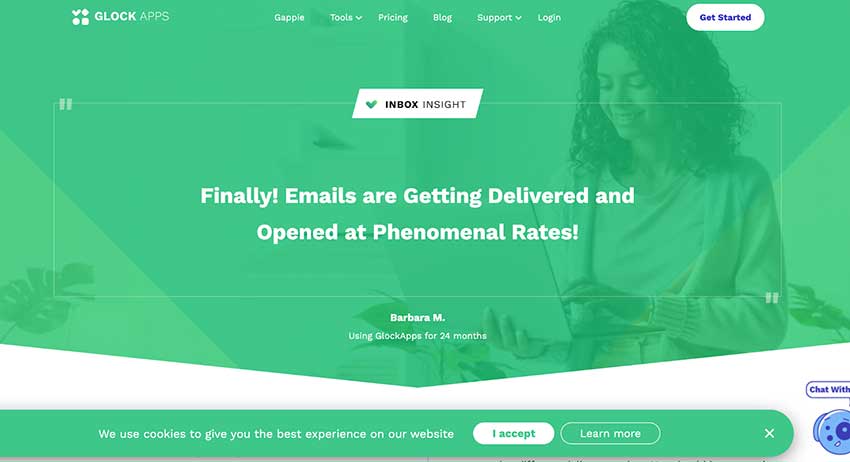
All you need to do is send one of your marketing emails to the address mentioned on the GlockApps website. The platform will resend your email through accounts and test all major mailbox providers. It will then generate a report that will show you where your email is likely to end up – in your prospect’s inbox, spam, or any other subfolder.
The tool will also give you a soam core and recommend adjustments to improve it. Overall, one of the best tools to get a comprehensive insight into your email deliverability.
5. SendForensics – Get Access to Email Deliverability Suite
This tool is specifically designed to help you address your email deliverability issues. Similar to GlockApps, you will be sending a copy of your email campaign to a unique address of SendForensics and receive a report in return.
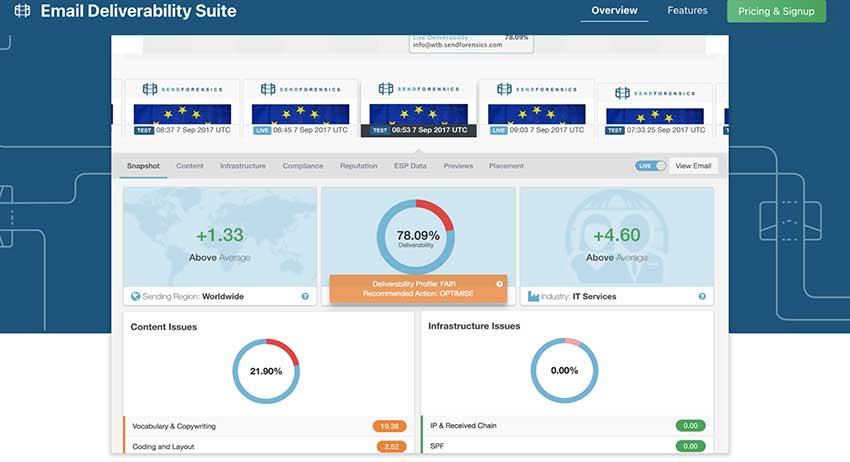
This comprehensive analysis will include any content or infrastructure issues, sender reputation, ESP data, and more. Even better, you can also optimize to receive statistics before and after sending the email.
As you can see, these tools are fully equipped to tell you where you need to make changes in crafting your email so that you can enhance your deliverability.
Conclusion
In order for your email campaigns to be effective, your emails should get delivered.
Before you get creative with a compelling subject line and content, you need to make sure that it aligns with the guidelines to pass the threshold of the inbox.
Email marketing can work wonders for you – it can help drive up engagement and boost your revenue. But first – make sure that you get those emails delivered.

 Return to Previous Page
Return to Previous Page








